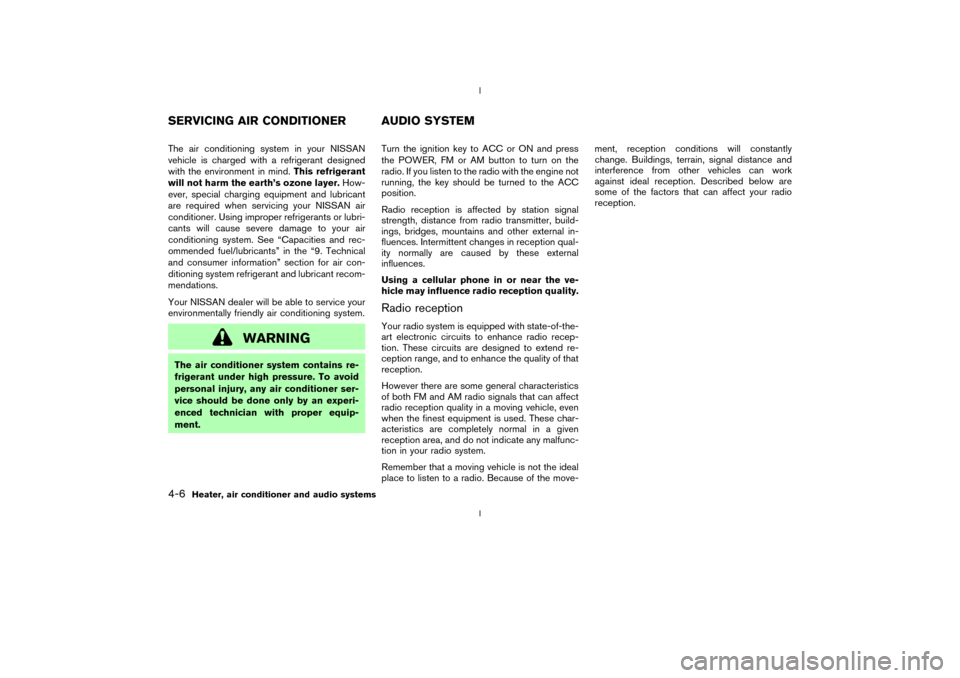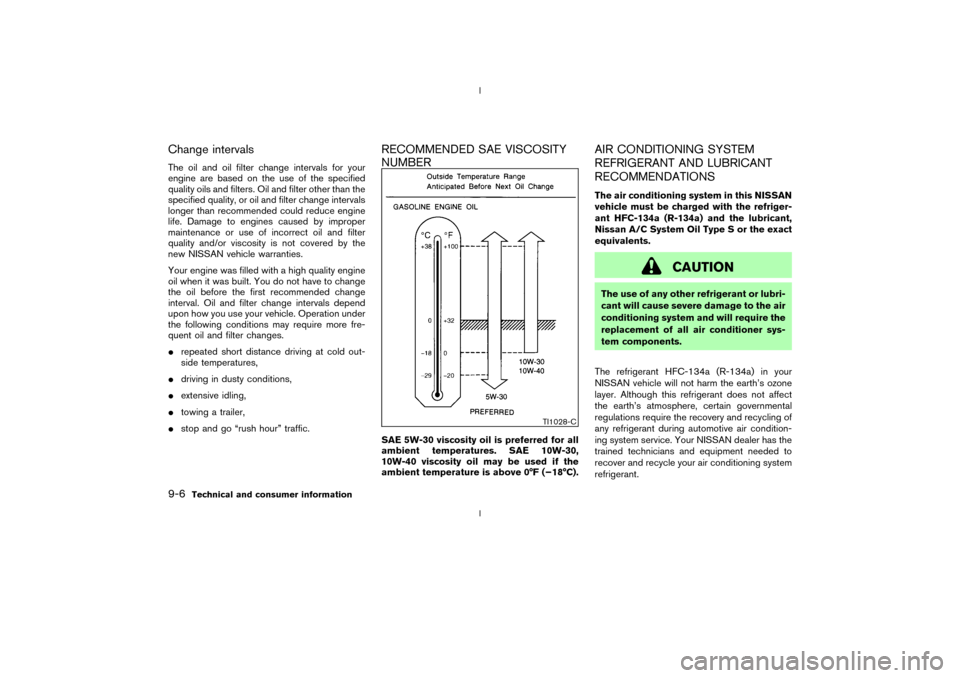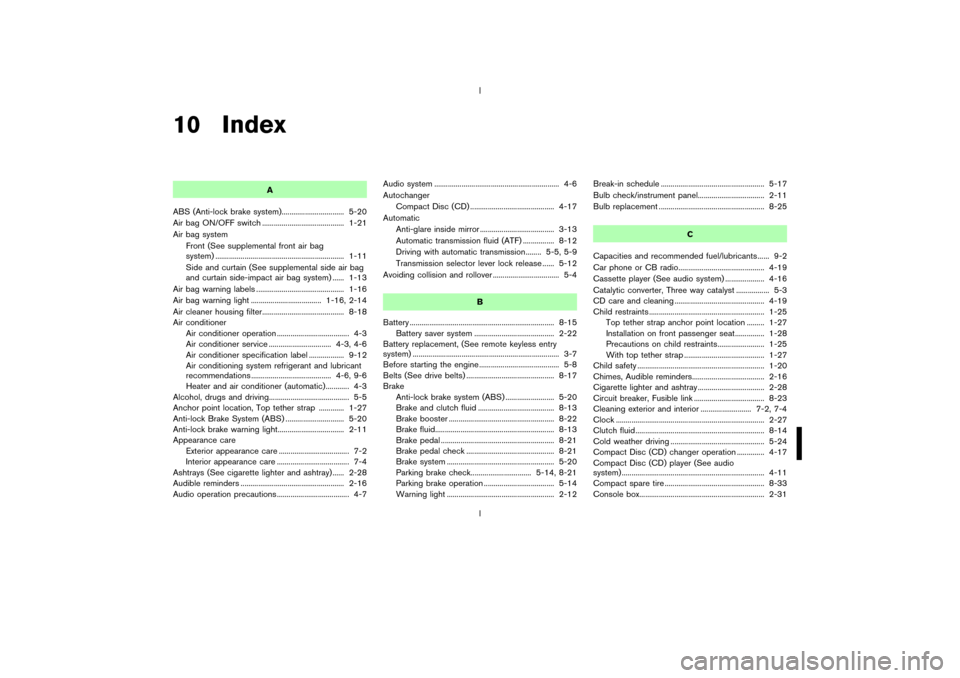2003 NISSAN 350Z air conditioning
[x] Cancel search: air conditioningPage 103 of 227

The air conditioning system in your NISSAN
vehicle is charged with a refrigerant designed
with the environment in mind.This refrigerant
will not harm the earth's ozone layer.How-
ever, special charging equipment and lubricant
are required when servicing your NISSAN air
conditioner. Using improper refrigerants or lubri-
cants will cause severe damage to your air
conditioning system. See ªCapacities and rec-
ommended fuel/lubricantsº in the ª9. Technical
and consumer informationº section for air con-
ditioning system refrigerant and lubricant recom-
mendations.
Your NISSAN dealer will be able to service your
environmentally friendly air conditioning system.
WARNING
The air conditioner system contains re-
frigerant under high pressure. To avoid
personal injury, any air conditioner ser-
vice should be done only by an experi-
enced technician with proper equip-
ment.Turn the ignition key to ACC or ON and press
the POWER, FM or AM button to turn on the
radio. If you listen to the radio with the engine not
running, the key should be turned to the ACC
position.
Radio reception is affected by station signal
strength, distance from radio transmitter, build-
ings, bridges, mountains and other external in-
fluences. Intermittent changes in reception qual-
ity normally are caused by these external
influences.
Using a cellular phone in or near the ve-
hicle may influence radio reception quality.
Radio receptionYour radio system is equipped with state-of-the-
art electronic circuits to enhance radio recep-
tion. These circuits are designed to extend re-
ception range, and to enhance the quality of that
reception.
However there are some general characteristics
of both FM and AM radio signals that can affect
radio reception quality in a moving vehicle, even
when the finest equipment is used. These char-
acteristics are completely normal in a given
reception area, and do not indicate any malfunc-
tion in your radio system.
Remember that a moving vehicle is not the ideal
place to listen to a radio. Because of the move-ment, reception conditions will constantly
change. Buildings, terrain, signal distance and
interference from other vehicles can work
against ideal reception. Described below are
some of the factors that can affect your radio
reception.
SERVICING AIR CONDITIONER AUDIO SYSTEM4-6
Heater, air conditioner and audio systems
Z
02.9.13/Z33-D/V5.0
X
Page 196 of 227

9 Technical and consumer informationCapacities and recommended fuel/lubricants ................ 9-2
Fuel recommendation...................................................... 9-3
Engine oil and oil filter recommendation.................... 9-5
Recommended SAE viscosity number ....................... 9-6
Air conditioning system refrigerant and lubricant
recommendations ............................................................. 9-6
Specifications.......................................................................... 9-8
Engine ................................................................................. 9-8
Wheels and tires .............................................................. 9-9
Dimensions and weights ................................................ 9-9
When traveling or registering your vehicle in another
country.................................................................................... 9-10
Vehicle identification ........................................................... 9-10
Vehicle identification number (VIN) plate ................ 9-10
Vehicle identification number (Chassis number) ... 9-10
Engine serial number .................................................... 9-11
F.M.V.S.S. certification label ....................................... 9-11
Emission control information label ............................ 9-11Tire placard ..................................................................... 9-12
Air conditioner specification label ............................. 9-12
Installing front license plate .............................................. 9-13
Vehicle loading information ............................................... 9-14
Terms ................................................................................ 9-14
Determining vehicle load capacity ............................ 9-14
Loading tips .................................................................... 9-15
Towing a trailer .................................................................... 9-15
Maximum load limits ...................................................... 9-16
Towing safety.................................................................. 9-17
Uniform tire quality grading............................................... 9-19
Emission control system warranty ................................... 9-20
Reporting safety defects (US only) ................................ 9-20
Readiness for inspection/maintenance (I/M) test
(US only)................................................................................ 9-21
Owner's manual/service manual order information ... 9-22
In the event of a collision ............................................ 9-22
Z
02.9.13/Z33-D/V5.0
X
Page 197 of 227

The following are approximate capacities. The actual refill capacities may be a little different. When refilling, follow the procedure
instructed in the ª8. Maintenance and do-it-yourselfº section to determine the proper refill capacity.
Capacity (Approximate)
Recommended
specifications US
measureImp
measureLiter
Fuel 20 gal 16-5/8 gal 76 Unleaded premium gasoline with an octane rating of at least 91 AKI (RON 96)*1
Engine oil (Drain and refill)*2
With oil filter change 5 qt 4-1/8 qt 4.7IAPI Certification Mark*3, *4
IAPI grade SG/SH, Energy ConservingI&IIorAPIgrade SJ or SL, Energy
Conserving*3, *4
IILSAC grade GF-I, GF-II & GF-III*2, *3 Without oil filter change 4-5/8 qt 3-7/8 qt 4.4
Cooling system
With reservoir 9-1/4 qt 7-5/8 qt 8.7
Genuine NISSAN anti-freeze coolant or equivalent
Reservoir 7/8 qt 3/5 qt 0.8
Automatic transmission fluid Ð Ð Ð Genuine Nissan ATF Matic Fluid J or exact equivalent*5
Manual transmission gear oil Ð Ð Ð API GL-4, Viscosity SAE 75W-85
Differential gear oil Ð Ð Ð API GL-5, Viscosity SAE 80W-90*6
Power steering fluid
Refill to the proper oil level according to the instructions in
the ª8. Maintenance and do-it-yourselfº section.Genuine Nissan PSF II or equivalent*7
Brake and clutch fluidGenuine Nissan Brake Fluid*8 or equivalent DOT 3 (U.S. FMVSS No. 116)
Multi-purpose grease Ð Ð Ð NLGI No. 2 (Lithium soap base)
Air conditioning system refrigerant Ð Ð Ð HFC-134a (R-134a)*9
Air conditioning system lubricants Ð Ð Ð Nissan A/C System Oil Type S or exact equivalent
*1: For additional information, see ªFuel recommendationº later in this chapter.
*2: For additional information, see ªEngine oilº in the ª8. Maintenance and do-it-yourselfº section for changing engine oil.
*3: For additional information, see ªEngine oil and oil filter recommendationº later in this chapter.
*4: For additional information, see ªRecommended SAE viscosity numberº later in this chapter.
*5: Using automatic transmission fluid other than Nissan Genuine ATF Matic Fluid J will cause deterioration in driveability and automatic transmission durability, and may
damage the automatic transmission, which is not covered by the NISSAN new vehicle limited warranty.
*6: For hot areas, viscosity SAE 90 is suitable for ambient temperatures above 32ÉF (0ÉC).
*7: Genuine Nissan PSF, Canada Nissan Automatic Transmission fluid, Dexron
TMIII/Mercon
TMor equivalent ATF may also be used.
*8: Available in mainland US through your NISSAN dealer.
*9: For additional information, see ªVehicle identificationº in this section for air conditioner specification label.
CAPACITIES AND
RECOMMENDED FUEL/
LUBRICANTS9-2
Technical and consumer information
Z
02.9.13/Z33-D/V5.0
X
Page 201 of 227

Change intervalsThe oil and oil filter change intervals for your
engine are based on the use of the specified
quality oils and filters. Oil and filter other than the
specified quality, or oil and filter change intervals
longer than recommended could reduce engine
life. Damage to engines caused by improper
maintenance or use of incorrect oil and filter
quality and/or viscosity is not covered by the
new NISSAN vehicle warranties.
Your engine was filled with a high quality engine
oil when it was built. You do not have to change
the oil before the first recommended change
interval. Oil and filter change intervals depend
upon how you use your vehicle. Operation under
the following conditions may require more fre-
quent oil and filter changes.
Irepeated short distance driving at cold out-
side temperatures,
Idriving in dusty conditions,
Iextensive idling,
Itowing a trailer,
Istop and go ªrush hourº traffic.
RECOMMENDED SAE VISCOSITY
NUMBERSAE 5W-30 viscosity oil is preferred for all
ambient temperatures. SAE 10W-30,
10W-40 viscosity oil may be used if the
ambient temperature is above 0ÉF (þ18ÉC).
AIR CONDITIONING SYSTEM
REFRIGERANT AND LUBRICANT
RECOMMENDATIONSThe air conditioning system in this NISSAN
vehicle must be charged with the refriger-
ant HFC-134a (R-134a) and the lubricant,
Nissan A/C System Oil Type S or the exact
equivalents.
CAUTION
The use of any other refrigerant or lubri-
cant will cause severe damage to the air
conditioning system and will require the
replacement of all air conditioner sys-
tem components.
The refrigerant HFC-134a (R-134a) in your
NISSAN vehicle will not harm the earth's ozone
layer. Although this refrigerant does not affect
the earth's atmosphere, certain governmental
regulations require the recovery and recycling of
any refrigerant during automotive air condition-
ing system service. Your NISSAN dealer has the
trained technicians and equipment needed to
recover and recycle your air conditioning system
refrigerant.
TI1028-C
9-6
Technical and consumer information
Z
02.9.13/Z33-D/V5.0
X
Page 202 of 227

Contact your NISSAN dealer when servicing
your air conditioning system.
Technical and consumer information
9-7
Z
02.9.13/Z33-D/V5.0
X
Page 213 of 227

load, worn suspension or other possible
causes of either condition.
IAlways secure items in the trailer to prevent
load shifts while driving.
IBe certain your rear view mirrors conform to
all federal, state or local regulations. If not,
install any mirrors required for towing before
driving the vehicle.
Trailer towing tipsIn order to gain skill and an understanding of the
vehicle's behavior, you should practice turning,
stopping and backing up in an area which is free
from traffic. Steering stability, and braking per-
formance will be somewhat different than under
normal driving conditions.
IAlways secure items in the trailer to prevent
load shift while driving.
IAvoid abrupt starts, acceleration or stops.
IAvoid sharp turns or lane changes.
IAlways drive your vehicle at a moderate
speed.
IAlways block the wheels on both vehicle and
trailer when parking. Parking on a slope is not
recommended; however, if you must do so,
and if your vehicle is equipped with automatic
transmission, first apply the parking brakeand block the wheels, and then move the
transmission selector lever into the P (Park)
position. If you move the selector lever to the
P (Park) position before blocking the wheels
and applying the parking brake, the transmis-
sion may get damaged.
IWhen going down a hill, shift into a lower
gear and use the engine braking effect.
When ascending on a long grade, downshift
the transmission to a lower gear and reduce
speed to reduce chances of engine overload-
ing and/or overheating.
IIf the engine coolant rises to an extremely
high temperature when the air conditioning
system is on, turn off the air conditioner.
Coolant heat can be additionally vented by
opening the windows, switching the fan con-
trol to high and setting the temperature con-
trol to the HOT position.
ITrailer towing consumes more fuel than nor-
mal circumstances.
IAvoid towing a trailer for the first 500 miles
(800 km).
IHave your vehicle serviced more often than at
intervals specified in the recommended main-
tenance schedule.
IWhen making a turn, your trailer wheels will
be closer to the inside of the turn than yourvehicle wheels. To compensate for this, make
a larger than normal turning radius during the
turn.
ICrosswinds and rough roads will adversely
affect vehicle/trailer handling, possibly caus-
ing vehicle sway. When being passed by
larger vehicles, be prepared for possible
changes in crosswinds that could affect ve-
hicle handling. If swaying does occur, firmly
grip the steering wheel, steer straight ahead,
and immediately (but gradually) reduce ve-
hicle speed. This combination will help stabi-
lize the vehicle. Never increase speed.
IBe careful when passing other vehicles.
Passing while towing a trailer requires con-
siderably more distance than normal passing.
Remember the length of the trailer must also
pass the other vehicle before you can safely
change lanes.
ITo maintain engine braking efficiency and
electrical charging performance, do not use
6th gear (manual transmission) or 5th posi-
tion (automatic transmission).
IAvoid holding the brake pedal down too long
or too frequently. This could cause the brakes
to overheat, resulting in reduced braking ef-
ficiency.
When towing a trailer, change transmis-9-18
Technical and consumer information
Z
02.9.13/Z33-D/V5.0
X
Page 220 of 227

10 Index
A
ABS (Anti-lock brake system)................................ 5-20
Air bag ON/OFF switch .......................................... 1-21
Air bag system
Front (See supplemental front air bag
system) .................................................................. 1-11
Side and curtain (See supplemental side air bag
and curtain side-impact air bag system) ...... 1-13
Air bag warning labels ............................................. 1-16
Air bag warning light .................................... 1-16, 2-14
Air cleaner housing filter.......................................... 8-18
Air conditioner
Air conditioner operation ..................................... 4-3
Air conditioner service ................................ 4-3, 4-6
Air conditioner specification label .................. 9-12
Air conditioning system refrigerant and lubricant
recommendations ......................................... 4-6, 9-6
Heater and air conditioner (automatic)............ 4-3
Alcohol, drugs and driving......................................... 5-5
Anchor point location, Top tether strap ............. 1-27
Anti-lock Brake System (ABS) .............................. 5-20
Anti-lock brake warning light.................................. 2-11
Appearance care
Exterior appearance care .................................... 7-2
Interior appearance care ..................................... 7-4
Ashtrays (See cigarette lighter and ashtray)...... 2-28
Audible reminders ..................................................... 2-16
Audio operation precautions ..................................... 4-7Audio system ................................................................ 4-6
Autochanger
Compact Disc (CD) ........................................... 4-17
Automatic
Anti-glare inside mirror ...................................... 3-13
Automatic transmission fluid (ATF) ................ 8-12
Driving with automatic transmission........ 5-5, 5-9
Transmission selector lever lock release ...... 5-12
Avoiding collision and rollover .................................. 5-4
B
Battery .......................................................................... 8-15
Battery saver system ......................................... 2-22
Battery replacement, (See remote keyless entry
system) ........................................................................... 3-7
Before starting the engine ......................................... 5-8
Belts (See drive belts) ............................................. 8-17
Brake
Anti-lock brake system (ABS) ......................... 5-20
Brake and clutch fluid ....................................... 8-13
Brake booster ...................................................... 8-22
Brake fluid............................................................. 8-13
Brake pedal .......................................................... 8-21
Brake pedal check ............................................. 8-21
Brake system ....................................................... 5-20
Parking brake check............................... 5-14, 8-21
Parking brake operation .................................... 5-14
Warning light ....................................................... 2-12Break-in schedule ..................................................... 5-17
Bulb check/instrument panel.................................. 2-11
Bulb replacement ...................................................... 8-25
C
Capacities and recommended fuel/lubricants...... 9-2
Car phone or CB radio............................................ 4-19
Cassette player (See audio system) .................... 4-16
Catalytic converter, Three way catalyst ................. 5-3
CD care and cleaning .............................................. 4-19
Child restraints ........................................................... 1-25
Top tether strap anchor point location ......... 1-27
Installation on front passenger seat............... 1-28
Precautions on child restraints........................ 1-25
With top tether strap ......................................... 1-27
Child safety ................................................................. 1-20
Chimes, Audible reminders..................................... 2-16
Cigarette lighter and ashtray .................................. 2-28
Circuit breaker, Fusible link .................................... 8-23
Cleaning exterior and interior .......................... 7-2, 7-4
Clock ............................................................................ 2-27
Clutch fluid.................................................................. 8-14
Cold weather driving ................................................ 5-24
Compact Disc (CD) changer operation .............. 4-17
Compact Disc (CD) player (See audio
system) ......................................................................... 4-11
Compact spare tire ................................................... 8-33
Console box................................................................ 2-31
Z
02.9.13/Z33-D/V5.0
X